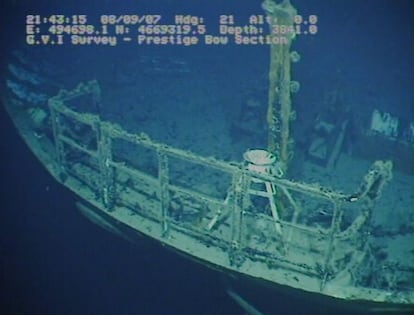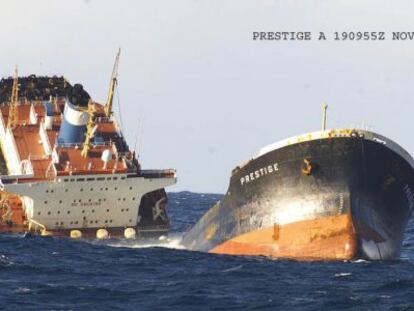Six years without an inspection
Leaks in the Prestige were detected in 2006 but Spain has not conducted tests

Two hundred and fifty kilometers off the coast of Galicia, a shipwreck rests at a depth of 3,500 meters. It has been there since November 2002, when it snapped in two and sank with its cargo of 77,000 metric tons of crude oil after the Spanish, French and Portuguese governments refused to let it come to shore at the first sign of trouble.
The oil spill from the Prestige polluted the coastline in all three countries, and became Spain's worst environmental disaster on record. Despite that, the nine-month trial that ended last week (after a 10-year investigation) found no guilty parties, and simply slapped the captain with a light fine for disobedience.
Inside the shipwreck there is still an unspecified amount of oil. The Spanish government says it is 700 tons; some investigators speak of 30 times that amount. Nobody knows for sure, as nobody has gone down to check in the last six years. The only way the government would ever find out about a new spill in the area, which is far away from trade routes and fishing grounds, is if they were told about it by the European Maritime Safety Agency, which takes satellite photographs of the area two or three times a week.
But the Prestige is not the only potential hazard whose surveillance the government - run by the center-right Popular Party (PP), which was also in power when the ship went down - leaves in the hands of international agencies. Spain is also doing nothing about the thousands of tons of radioactive waste that was dumped by several countries up to 1982 inside metal and concrete drums. Scientists are warning that there could be new spills at any time, either from the Prestige or from the waste drums, although they disagree on the extent of the potential pollution.
It wouldn't be a bad idea to check on them from time to time"
The last time anyone went down to check on the shipwreck was September 2007. A year and a half earlier, fuel oil had been detected on the water surface, prompting the government to ask oil company Repsol to send a submarine down to inspect the remains and seal any cracks. The operation cost seven million euros.
The Spanish Oceanographic Institute confirms that for years now, "absolutely nothing has being done" to keep tabs on the Prestige. Nor has the Hydrographic Institute of Portugal been by, even though at the time of the disaster it offered more reliable information about the spill than the Spanish government. The Portuguese Navy says it has "no record in connection with the Prestige."
Last January, the government told Congress that the 2007 inspection found all the cracks and potential leak spots "in perfect condition"; it further held that the wreck "merely contains small pockets of fuel whose extraction is impossible and that represent no risk of a spill." The government further claimed that it had received "no notice" about fuel stains "despite intensive surveillance over the area."
The Public Works Ministry admits that this "intensive surveillance" is that being conducted by the European agency. Between 2011 and 2012, it says, 165 photographs were taken, and "none of them showed any pollution in a 15-mile radius around the position of the wreck." This year, "some 120 pictures" have been taken.
José Luis de Pablos, of the Center for Environmental and Technological Research (which answers to the Economy Ministry), investigated the erosion of the Prestige years ago. While he would not venture to say what the wreck might be like now, he remembers the study he published in 2004 with colleagues from the Spanish National Research Council (CSIC). This report estimated that the first cracks would appear in 2006, rather than in 2025 as the government then claimed. And indeed, the first leaks were detected in 2006, prompting the 2007 submarine expedition.
Victoriano Urgorri, a biologist and director of a scientific research station in Ferrol, believes that the Prestige is no longer that dangerous ("the bacteria will have helped break down the remaining fuel") compared with the radioactive waste drums, whose present state is an unknown factor. "If anyone had conducted an investigation in recent years, they would have published something."
Fiz Fernández, of the CSIC's Marine Research Institute in Vigo, was one of the first people to go down in a submarine in 2002 to inspect the remains of the Prestige. He believes another mission should be sent to the shipwreck, and the waste drums.
"They don't need to send a person; there are unmanned submarines," he says. As for the drums, since they are located in international waters, "Spain does not have to conduct surveillance, international agencies can do that. But it wouldn't be a bad idea to check on them from time to time."
Uncontrolled nuclear waste
Across a broad swath of the Atlantic seabed, eight countries (the UK, Belgium, the Netherlands, France, Switzerland, Sweden, Germany and Italy) deposited almost 140,000 metric tons of nuclear waste between 1949 and 1982, according to the International Atomic Energy Agency.
This waste was jettisoned in thousands of canisters in around 30 locations. Nobody is sure today what state the steel and concrete containers might be in. The last dumping was in conducted in 1982 by the Netherlands, 650 kilometers off the coast of Galicia, while waste dating from 1964 lies 200km from Asturias.
None of Spain's nuclear watchdogs keep an eye on the containers. Furthermore, they argue that the waste is in international waters and therefore under the International Maritime Organization's jurisdiction (IMO). The secretary of the IMO admitted a few years ago that inspecting the containers was "not a priority" due to the lack of "worrying data." But Greenpeace points out that "they are not going to go away just because nobody is looking."
Tu suscripción se está usando en otro dispositivo
¿Quieres añadir otro usuario a tu suscripción?
Si continúas leyendo en este dispositivo, no se podrá leer en el otro.
FlechaTu suscripción se está usando en otro dispositivo y solo puedes acceder a EL PAÍS desde un dispositivo a la vez.
Si quieres compartir tu cuenta, cambia tu suscripción a la modalidad Premium, así podrás añadir otro usuario. Cada uno accederá con su propia cuenta de email, lo que os permitirá personalizar vuestra experiencia en EL PAÍS.
¿Tienes una suscripción de empresa? Accede aquí para contratar más cuentas.
En el caso de no saber quién está usando tu cuenta, te recomendamos cambiar tu contraseña aquí.
Si decides continuar compartiendo tu cuenta, este mensaje se mostrará en tu dispositivo y en el de la otra persona que está usando tu cuenta de forma indefinida, afectando a tu experiencia de lectura. Puedes consultar aquí los términos y condiciones de la suscripción digital.
More information

Prestige judge finds “no criminal responsibility” for huge oil disaster
Últimas noticias
The complicated life of Francesca Albanese: A rising figure in Italy but barred from every bank by Trump’s sanctions
Reinhard Genzel, Nobel laureate in physics: ‘One-minute videos will never give you the truth’
Pinochet’s victims grapple with José Antonio Kast’s rise in Chile
How Japan is trying to avert ‘digital defeat’
Most viewed
- Why we lost the habit of sleeping in two segments and how that changed our sense of time
- Pablo Escobar’s hippos: A serious environmental problem, 40 years on
- Trump’s obsession with putting his name on everything is unprecedented in the United States
- The Florida Keys tourist paradise is besieged by immigration agents: ‘We’ve never seen anything like this’
- Charles Dubouloz, mountaineering star, retires at 36 with a farewell tour inspired by Walter Bonatti








































